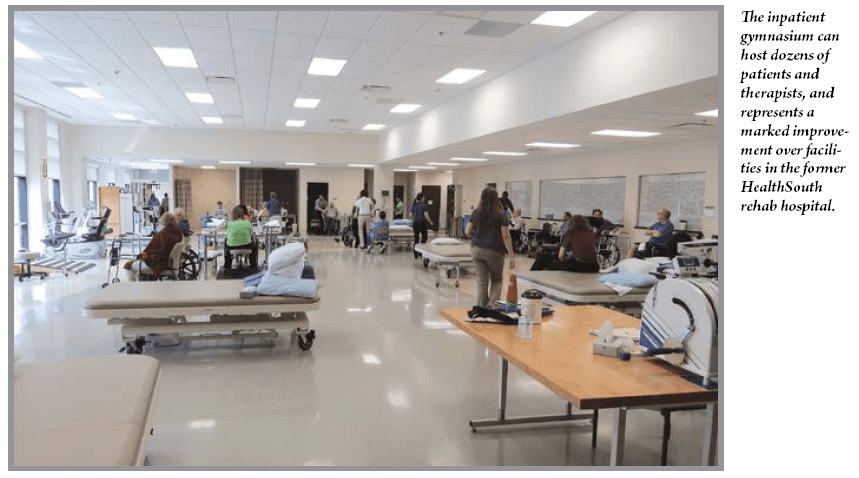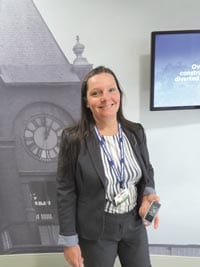Where the Past and the Future – Meet New HealthSouth Facility Opens Its Doors in Ludlow Mills Complex
Looking back, Victoria Healy recalled that providing tours of what is now the former HealthSouth rehabilitation hospital in Ludlow was not exactly a plum assignment.
“It was difficult giving tours there — that facility was not an easy sell,” said Healy, who gave more than a few over the years in her role as controller.
There were five floors to negotiate, she told HCN as she talked about the former Ludlow Hospital, an acute care hospital built in 1907, adding that the elevators were old and slow, the rooms had multiple patients and shared bathrooms, and the rehab areas were quite small.
All this made for competitive disadvantages at a time when patients and their families were becoming far more discerning about where and how they receive care, and doing their homework before choosing a provider.
“What we’re finding now is that people are really educated, and if they’re going to have surgery they believe will require rehab after the fact, like having both knees replaced, they’re doing the legwork up front,” she explained. “They’re figuring out where they’re going to go before they need it.”
And these days, giving such tours is a very welcome assignment for Healy, now the facility’s CEO, and anyone else who gets to do the honors.
That’s because the new, $28 million HealthSouth, built at the Ludlow Mills complex and opened last December, is state of the art in every sense of that phrase — from its pending LEED (Leadership in Energy and Environmental Design) certification, to the private rooms and accompanying spacious bathrooms; from the large inpatient gym, where occupational, physical, and speech therapists work with patients, to the courtyard, which doubles as what Healy called a “functional therapy gym” (more on that later).
“Tours are a lot more fun here — this building sells itself,” she told HCN, adding that there have been dozens of visits in recent weeks, from prospective patients and their families, town officials, the press, and other constituencies.
But while the new, 53-bed, 74,000-square-foot HealthSouth is a model of the present and, in many respects, future of rehabilitation services, there is also a nod, actually several of them, to the past. In this case, it’s the the hospital’s new home, the massive former jute-manufacturing complex that is now the site of an ambitious redevelopment project being undertaken by Westmass Area Development Corp.
Indeed, the HealthSouth facility is one of the first undertakings within this initiative, which includes both new construction and repurposing old mills, and those constructing and then decorating the hospital acknowledged the rich history of the site.
For starters, 100,000 bricks salvaged from some of the dozens of historic stock houses that populate the property were used in the construction of the new hospital. They can be seen in the front lobby, which also features several planed wooden beams from those stockhouses, several photos of the mills, and a large mural featuring the signature clock tower that dominates the property and has become the town’s most-recognized landmark.

Meanwhile, artwork adorning corridors throughout the facility comes in a mix — a colorful collection of photographs of area landmarks (everything from Mount Greylock to Westfield’s Tekoa Country Club), as well as a number of vintage photos, many a century or more old, including many of the old mill complex and the nearby Putts Bridge that links Ludlow with Indian Orchard, as well as other town landmarks.
Healy said an early favorite among patients and staff alike is an image from the maternity unit at the former Springfield Hospital, circa 1905, showing nine infants on one large cart.
“We originally thought those were loaves of bread, but they’re babies,” she said. ‘Times have definitely changed.”
For this issue, HCN took one of the many tours being offered these days by Healy and her staff to gain some perspective on what this new facility means for the organization in terms of serving patients and achieving desired growth.
It’s Not Run of the Mill
Healy, who joined HealthSouth’s Ludlow operation in 1999, a few years after the corporation acquired it from Advantage Rehabilitation, which set up shop soon after Ludlow Hospital closed its doors in the early ‘90s, said administrators have known for some time that larger, more efficient, and far more modern facilities were needed.
Indeed, while the company has a reputation for good outcomes for its patients and has long enjoyed a high occupancy rate (roughly 90{06cf2b9696b159f874511d23dbc893eb1ac83014175ed30550cfff22781411e5}), the multi-level, 60,000-square-foot facility presented some real challenges.
The 53 beds were placed in far fewer rooms than the current facility, she explained, noting that there were often three or four patients to a room. This created issues with privacy and infection control, she said, but also presented some logistical problems.
For example, as the patient population shifted, gender-wise, patients would have to be moved, often several times during a typical two-week stay, said Healy, adding that this was an inconvenience for both patients and their families.
“We had such a high occupancy rate, in order to accommodate more patients, we had to do a lot of room moves,” she noted. “In an average length of stay of 13 days, a patient might move three or four times.”
And then, there were the multiple beds and common bathrooms, which, suffice it to say, were not the highlights of those aforementioned tours.
“When the younger generations toured and saw the three- and four-bed rooms and the shared bathroom, they were not interested in coming to our hospital,” Healey noted, “especially when they came from either BayState or Wing and the new units at those facilities, which featured all private rooms.
“And the bathrooms we had at the old hospital were more like toilets,” she went on. “The sinks were outside the bathroom, and the showers were toward the nursing unit. It was more like a gym shower.”
These and other problems and challenges are now talked about nostalgically, if that’s the right term, by HealthSouth’s staff of 225.
That’s because the new facility has large private rooms and attached baths, spacious gyms, generous amounts of glass everywhere, solar panels on the roof, and much more.
“It’s a huge change — like night and day,” said Healy with a laugh, adding that the new facility allows for the same patient outcomes, a better patient experience, and a far more appealing environment in which the staff can work.
All of the above became evident as Healy offered HCN a tour, starting outside her office in the administrative area. Nearly 20 people now work in one designated area — where before they were spread throughout the old hospital — allowing for better communication and improved productivity.
But the hospital really exists for its patients, she said, before moving quickly through the lobby and to an outpatient-treatment area that represents a vast improvement over the same facility at the old Ludlow Hospital, enabling HealthSouth to better compete in a crowded field of outpatient-service providers, which is a small but still important component of the business.
The main thrust is inpatient care, she said while moving on to the two wings with patient rooms for those recovering from everything from stroke and other neurological disorders to spinal cord injury; from amputations to cardiac and pulmonary conditions.
While these rooms have become a strong selling point for those doing that aforementioned legwork that Healy described, there are many other amenities.
These include a spacious day room where patients and their families can relax and spend time together. Activities range from Bingo to church services, said Healy, adding that there is another gathering space unofficially named the ‘night room,’ she noted, because it doesn’t have the huge windows that define the ‘day room.’
Around the corner is the large inpatient gym, which can accommodate several dozen patients and therapists at one time.
And then, there’s the large courtyard, which, as she said, doubles as a functional therapy gym. There are stairs, handrails, and several slight changes in elevation, Healy noted, adding that navigating all this can certainly assist many patients in their recovery efforts.
“One of the challenges that many patients have as they’re learning, especially after a stroke or a car accident, is that it’s very difficult for them to learn to walk on different surfaces,” she explained. “So here, there’s stairs, ramps, brick, concrete, stone, and sand. After a life-changing event, it’s very difficult to learn how to re-ambulate on surfaces like this, so we’re excited about what we can do here.
“Also, I think it’s good therapy for the soul to have the fresh air and the sunshine,” she went on. “Our goal is to get people back to their lives, and this (courtyard) is closer to life than anything a hospital can simulate.”
The facility has been closed through the long, harsh winter, said Healy, but now that spring has finally sprung, patients and their therapists are taking full advantage of the opportunities afforded them.
The new hospital comes complete with a large amount of shell space, said Healy, adding that the ultimate goal is to expand into that space with more patient rooms.
To do so, HealthSouth will have to convince state health officials there is sufficient need, she said, adding that at the moment, this would be difficult to do because most competing facilities have lower occupancy rates.
“There is space for an additional 17 beds, and it’s our goal to eventually expand into it,” she said, adding that as the population ages and need for rehab services rises, this space will eventually be put to use.
Making More History
That shell space is currently not on the agenda for most of the tours being given at the new HealthSouth, but there are plenty of other things to see and experience, said Healy, reiterating, again, how much more enjoyable it is to introduce people to this facility than the old hospital, just a few blocks away.
“It’s the best part of my day,” she told HCN, adding that the new facility provides the room to grow and an environment in which patients and staff can thrive.
Which means it’s a place where more history can be made.


